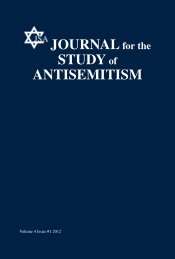Journal for the Study of Antisemitism
Journal for the Study of Antisemitism
Journal for the Study of Antisemitism
Create successful ePaper yourself
Turn your PDF publications into a flip-book with our unique Google optimized e-Paper software.
When Fairy Tales Kill<br />
Steven K. Baum*<br />
The author examines <strong>the</strong> link between social fantasies <strong>of</strong> Jews and<br />
antisemitic attacks over <strong>the</strong> past millennia. He concludes that hundreds <strong>of</strong><br />
thousands <strong>of</strong> Jews have been killed largely based on social fantasy,<br />
superstition, and legend.<br />
When we first heard <strong>of</strong> <strong>the</strong> political myths, we found <strong>the</strong>m so absurd and<br />
incongruous, so fantastic and ludicrous, that we could hardly be prevailed<br />
upon to take <strong>the</strong>m seriously. By <strong>the</strong> end <strong>of</strong> <strong>the</strong> war, however, it had<br />
become clear to all <strong>of</strong> us that this was a great mistake. . . The mythical<br />
monsters were not entirely destroyed. They were used <strong>for</strong> <strong>the</strong> creation <strong>of</strong><br />
a new universe and <strong>the</strong>y still survive in this universe.<br />
— Ernst Cassirer, philosopher<br />
Historian Ian Kershaw once said that <strong>the</strong> road to Auschwitz was paved<br />
with indifference. That indifference may have reflected <strong>the</strong> community’s<br />
negative feelings toward Jews. Such negative feelings may initially be<br />
based on fantasy, but soon become all too real to those given to such fantasy<br />
(Baum 2008). The transition from antisemitic fantasy to antisemitic act<br />
may be an easy leap. Romanian researcher Andrei Oi¸steanu (2009, 4) likens<br />
it to a ratio: “The greater <strong>the</strong> gap between <strong>the</strong> real Jew and <strong>the</strong> imaginary<br />
Jew, <strong>the</strong> greater was popular Judeophobia.”<br />
Freudians such as Bruno Bettelheim believed that folk tales prepared<br />
children <strong>for</strong> maturation, but rarely mentioned <strong>the</strong> politics inherent in ethnic<br />
tall tales. Among religious/ethnic groups, Jews were overly represented in<br />
negative terms. The <strong>for</strong>ms <strong>of</strong> legend varied, but made <strong>the</strong>ir way into Mo<strong>the</strong>r<br />
Goose poems. Up until <strong>the</strong> 1930s, children could read Jack and <strong>the</strong> Beanstalk<br />
with <strong>the</strong> following passage (Burnstein 1959).<br />
* Steven K. Baum is a clinical psychologist who lives in Albuquerque, New<br />
Mexico. He is co-editor <strong>of</strong> <strong>the</strong> <strong>Journal</strong> <strong>for</strong> <strong>the</strong> <strong>Study</strong> <strong>of</strong> <strong>Antisemitism</strong>.<br />
Note: I would like to thank Steven L. Jacobs, Paul Bartop, Gün<strong>the</strong>r Jikeli, and<br />
Frederick Schweitzer <strong>for</strong> <strong>the</strong>ir critiques. Additionally, I wish to note that I use<br />
myth and legend interchangeably at times due to <strong>the</strong> fantasy aspect <strong>of</strong> both terms.<br />
187














